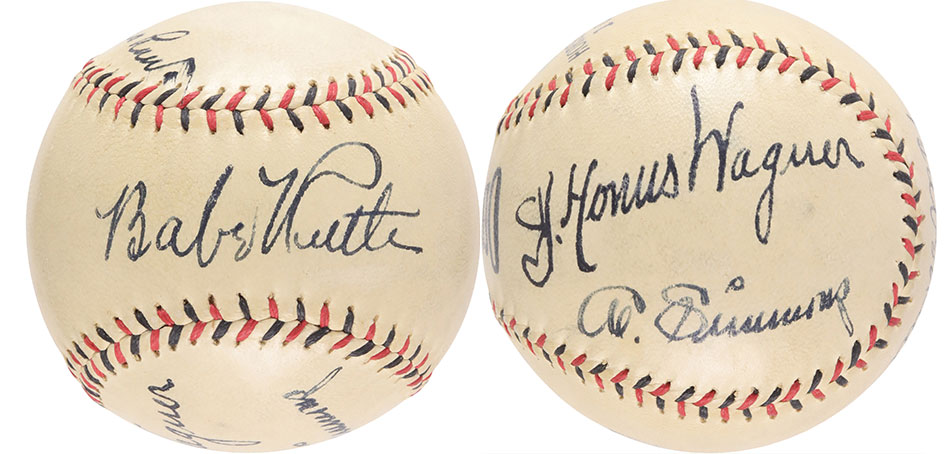Exceptional Ruth/Wagner Signed Baseball Hidden in Grandma's Drawer for 60 Years Heads to Auction

By David Seideman
In the mid-1990s, a grandson was visiting his grandmother in San Pedro, California. At the time he was playing in an adult baseball league, which prompted her to tell him, "I have something for you."
She then reached into a drawer and tossed him a clean, slightly toned base-ball with writing as if it came from a playground. He looked at it and his eyes bugged out. In black fountain pen, there were the beautifully scripted signatures of Babe Ruth on the sweet spot and Honus Wagner on a side pan-el.
For six decades, the grandmother had completely forgotten about the ball her late husband had had autographed in the 1930s. She deemed it a family heirloom important enough as a piece of baseball history to store it away, but not so as important to refrain from keeping it the best keep secret in San Pedro, if not the sports collectible world. Her brother, children, and grand-children were all in the dark.
In 2014, the ball went from the least known of its kind to the most known after five million viewers saw it featured on The Antiques Roadshow. Today it continues its epic odyssey on February 25 when Lelands auction house sells it, privately or publicly, for the first time. The signatures of Ruth and Wagner, two of the first five inductees into the Baseball Hall of Fame in 1936, are seldom seen together on a baseball, and this may well be the finest such pairing in the hobby.
The baseball is an "Official Wilson League" bearing the stamped facsimile signature of "T. J. Hickey," who served as American Association president, mostly from 1917 through 1935. It also includes the autographs of Hall of Famer Al Simmons, one of the greatest hitters of his era who had a lifetime batting average of .334 and 2927 hits, and George Earnshaw, s dominant pitcher during the early 1930s. Along with Lefty Grove, he was one of the aces of the Philadelphia Athletics' 1929-1931 baseball dynasty, winning 67 games during that three-year span.
The ball was obtained in the mid-1930s by the consignor's grandfather. He worked for the US Department of Agriculture as an inspector of ships and avidly played amateur baseball during the 1920s. Two of the ships he in-spected were the Lurline and Watsonia, both of which traveled to the Hawai-ian Islands. While the exact history of the ball is unknown, the family be-lieves that the Ruth signature was most likely secured during Ruth's post-season tour of Hawaii in 1933, because he traveled on the Lurline at the time. There is no record of the other three players traveling with Ruth to Hawaii back then and it was always assumed that their signatures were ac-quired independently on different seafaring trips during the same time peri-od.
In 2014, Leila Dunbar, the well-respected independent appraiser and regular on Antiques Roadshow, went over the moon in front of the TV cameras in Charlottesville, VA. "It looks like it was signed yesterday!" she gushed " I have seen thousands of signed Ruth baseballs. This one, on a scale of one to ten, is a ten. The Honus Wagner is a ten. The ball is an eight. It's creamy. It's beautiful— the most spectacular signed baseball by Ruth and Wagner."
For its part, Lelands grades the Ruth 9/10 the Wagner signature, 9.5/10, the Simmons signature 8/10, and the Earnshaw 8/10.
Dunbar gave the baseball an insurance value of $30,000 (insurance values run a little higher than actual values to cover losses). "I am shocked," de-clared the grandson, now a retired government employee living in a small town in Virginia, who asked to remain anonymous. "I am floored."
He was even more shocked in 2022 when the baseball was showcased on the program again in 2022 and it earned an updated appraisal value of $80,000 almost three times the original one. "The Ruth autograph market has always been great, year after year," says Tom D'Alonso, an acquisition specialist for Lelands who handled the consignment. "You don't normally see a Wag-ner signature this nice on a baseball. Usually, you see it on a postcard or in-dex card. Plus it's a pretty rare combo. There are some induction balls. But there wouldn't have been a lot of occasions when they were on the field to-gether at the same time. Old timers games weren't until 1947. You would have to go out of your way."
After long thought, the consignor contacted Leila Dunbar to determine the best way to sell the baseball. "She singled out Lelands," the consignor said. "She gets nothing out of it."
His wife has vast experience in the art auction world and posed many ques-tions to Lelands before closing the deal such as why the opening bid was so low: $10,000. The answer is to stimulate interest by lifting more bidders' hopes. He signed the contract. "I have two boys," the 63-year-old explained. "One is a 28-year-old pilot in the Marine Corps. The other is intellectually delayed, 25, and works for a grocery store chain. Anything I can do for them has more meaning than a ball stuck in the drawer for 60 years."
The holy relic's long journey— from the Pacific Ocean, to the California coast, to national TV in Charlottesville, VA— will now continue to an un-known destination in the home of a happy new owner.
one year ago
